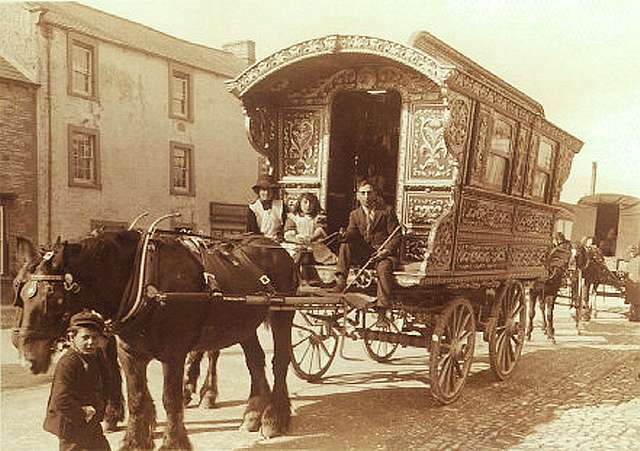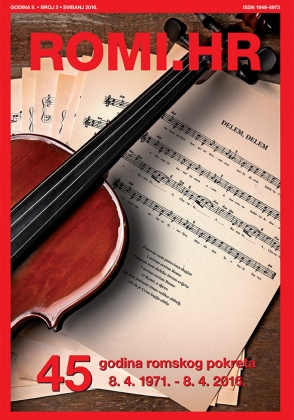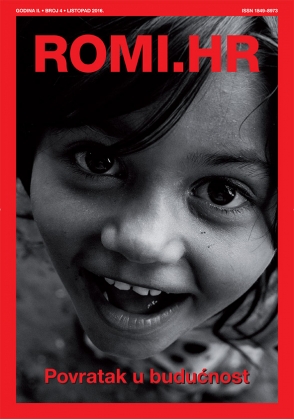Features ROMI.HR
/The nomadic way of life of Roma people has been a defining feature of their culture for centuries, shaped by a desire for mobility, independence and freedom. Travelling from place to place, often in search of work, community, or refuge, Roma maintained a lifestyle that was both practical and resilient. The vardo, or Romani wagon, was central to this way of life, providing not just a means of transport but also a mobile home.
The carts used by Roma varied depending on the country in which they lived. In Hungary and Romania, Roma moved in wagons with canvas roofs, while in Russia open carts were used most frequently. Roma of Poland, France and Germany travelled in wooden wagons, sometimes having to spend winters in them.
In the UK, the term vardo refers to the traditional carts used by Roma people and travellers (different groups of people in the UK and Ireland who have historically led a nomadic lifestyle). The word vardo is believed to be derived from the Ossetic word wærdon, which meant cart or carriage. These wagons became especially associated with Roma communities in the UK as they were often ornately decorated with vibrant colours, intricate carvings, and detailed paintings. Wagons were widely used from the mid-nineteenth century to the early twentieth century, having been replaced by caravans later on.
Typically, a vardo was pulled by a horse hitched in shafts. As the primary means of transport, horses were essential for pulling the wagons as Roma travelled from place to place. The vardo, though compact and functional, could be heavy, and the horses provided the strength needed to move these mobile homes over long distances. Originally using inexpensive or discarded horses to pull their chimneyed living wagons, Romanichal (Roma of the UK and other parts of the English-speaking world) gradually developed their own breed of horse. They carefully selected and cared for horses, often treating them as valuable companions.
The earliest Romany wagons were small, two-wheeled pot carts, known as sleeping carts. These carts featured a canvas cover that could be rolled down at the back, and the entrance was at the front, between the shafts. Later, between the mid-to-late 19th century, Roma in Britain began using wagons that included living spaces inside with beds, cupboards and numerous drawers. The doors opened outwards, which was crucial given the limited internal space. The side and back windows were shuttered and protected from breakage with interior window guards.
The vardo was heated by a stove that was fuelled with coal and placed on the leading side of the wagon, specifically to minimise the risk of damage from low-hanging tree limbs along the less-travelled roads near hedgerows. The stove could also serve for cooking, however, most of it was done outside. Paraffin lamps were used for lighting, though they posed significant fire risks if not handled properly. Churns and stainless-steel buckets were used to carry water, and campsites were selected with access to water in mind.
With no doubt, the most prominent feature of vardos is their appearance. Aiming to emulate the surroundings and manners of the wealthy people whose lands they travelled through, Romanichal decorated their vardos elaborately, hand carving and ornately painting the wagons with traditional symbols. The symbols reflected key aspects of Roma lifestyle, featuring images of horses and dogs, as well as common decorative motifs like birds, lions, griffins, flowers, vines, and intricate scrollwork. Carved details were often highlighted with gold, either painted or, in the most expensive wagons, gold leaf applied for decoration. Many individual craftsmen could be recognised by their unique designs, which became their signature style.
With each decade the decoration of vardos became richer, and the change in designs was partially influenced by the custom that, like other belongings, a vardo would be burned after the owner's death. For the same reason very few vardos have survived to the present day, unfortunately. Now vardos can be seen in museums and at fairs among which Appleby Horse Fair must be named, being the most famous. It has been held since 1685 in Cumbria, North West England and is attended by 10 000 Roma and Travellers every year attracting more than 30 000 visitors.
The beauty and unique style or vardos have inspired many people of art over the years, one of whom was famously John Lennon. In 1967, he gifted his son Julian a real vardo for his birthday. It had been purchased from Roma by order of Lennon, restored, and repainted. The body of the bright red and yellow vardo was decorated with numerous patterns, painted with images of animals and plants. Lennon developed a passion for this style while The Beatles were recording “Sgt Pepper's Lonely Hearts Club Band”. John's first wife, Cynthia, writes in her book “A Twist of Lennon” that when coming up with the visual concept for the album, Lennon was inspired by vardos.
The same year the famous musician had a brand new Rolls-Royce repainted bright yellow and embellished with motifs from Roma decorative arts by local Roma people. The car was decorated with intricate, vibrant swirls and floral patterns in the psychedelic style that became synonymous with The Beatles during that era, and it quickly turned into a sensation. After experiencing several renovations and changes of ownership, the car is currently displayed by the Royal British Columbia Museum.
Not only do Roma wagons serve a source of joy and inspiration, but they are also able to reflect tragic moments of Roma past. Babi Yar is a ravine in Kiev, the capital of Ukraine, where numerous massacres were carried out by Nazi forces during their invasion of the Soviet Union in World War II. In this land, people of many nationalities, mainly Jews, remain forever, of whom people of five Roma encampments, mostly defenceless women, the elderly, and children. It is estimated that a total of between 100,000 and 150,000 people were murdered at Babi Yar during the German occupation. Many years have passed since then and multiple generations have grown up. But human memory, along with the twenty-five monuments that stand at Babi Yar today, ensures that the events of those days are not forgotten.
Among these monuments there is one dedicated to the many Roma people buried at Babi Yar. Sculptor Anatoly Ihnashenko created an extraordinary monument in the form of a Romany wagon. After all, the caravan is a symbol of the people's journey across the land. The caravan represents the unity and life of the Roma family and the entire community. The metal vardo is life-sized, as if moving across the seemingly randomly scattered stones that form its foundation. The sides of this dwelling are densely perforated with bullet holes from machine gun fire with iron garlands of flowers wind around the caravan. These garlands hold a plaque inscribed in both Romani and Ukrainian: "To the Roma people exterminated by the fascists. 1941-1945."
Vardos have long served as both a practical vehicle and a home for Roma, embodying a nomadic way of life and adaptability to changing environments. Beyond their functional role, these caravans are also a testament to the artistic spirit of the community, each vardo being a unique piece of craftsmanship, blending utility with beauty. The vardo remains an enduring symbol of Roma's resilience, creativity, and rich cultural history.
 Back to Features
Back to Features













